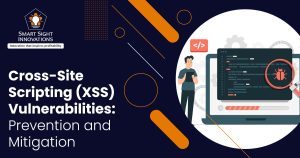 The internet is the foundation of our interconnected world in the modern digital age. Web applications and services are widespread, facilitating communication, e-commerce, and several other activities. However, this widespread use of the internet also brings about security challenges, and one of the most common and potentially devastating vulnerabilities is Cross-Site Scripting (XSS).
The internet is the foundation of our interconnected world in the modern digital age. Web applications and services are widespread, facilitating communication, e-commerce, and several other activities. However, this widespread use of the internet also brings about security challenges, and one of the most common and potentially devastating vulnerabilities is Cross-Site Scripting (XSS).
This article explains the different types of XSS vulnerabilities, how to prevent them and some of the major challenges when it comes to mitigating these attacks.
What Is Cross-Site Scripting (XSS)?
XSS is a security vulnerability that allows an attacker to inject malicious scripts into web pages viewed by other users. These scripts can be executed in the context of the victim’s browser, leading to the theft of sensitive information, session hijacking, and other malicious activities.
XSS can manifest in various forms, with the attacker manipulating input data in a way that forces the application to produce unescaped, malicious output. XSS is a significant concern for web security due to its potential for serious harm.
Vulnerable web applications can compromise user data, leading to financial losses, privacy breaches, and damage to a company’s reputation. It’s important to understand that XSS is not just a theoretical threat but a real and pervasive danger. A study by Trustwave SpiderLabs found that XSS is involved in about 40% of attack attempts in web applications, of all reported vulnerabilities.
Types of XSS Vulnerabilities
Each type of XSS vulnerability has unique characteristics and attack vectors. Understanding the differences is crucial for implementing appropriate prevention and mitigation strategies.
-
Stored XSS
Stored XSS occurs when the malicious script is permanently stored on a target server, such as in a database. When a user requests the affected resource, the server delivers the stored script, executing it in the user’s browser. Attackers may use this to target multiple users who access the same compromised resource.
-
Reflected XSS
Reflected XSS is characterized by the malicious script being embedded in a URL or a request’s parameters. When a user clicks on a crafted link or submits a vulnerable form, the script is executed immediately in the context of their browser. This type often requires social engineering tactics to execute the script.
-
DOM-Based XSS
DOM-based XSS is unique in that the vulnerability arises on the client-side. The attack occurs when a web application modifies the Document Object Model (DOM) based on untrusted data. The browser interprets the data and executes the script, potentially compromising the user’s session.
How Does XSS Attack Work?
XSS attacks typically begin with the attacker finding a vulnerability in a web application. This vulnerability may be present in user input fields, URL parameters, or other forms of user-controlled data. Once a vulnerability is identified, the attacker crafts a malicious payload that, when executed, achieves their goals, such as stealing user cookies or redirecting them to a malicious site. The payload is then delivered to the vulnerable application.
-
Common Targets for XSS Attacks
XSS attacks often target user sessions and sensitive information. Attackers seek to steal cookies containing session identifiers, allowing them to impersonate users and access their accounts. They can also manipulate the DOM to deface websites, insert malicious advertisements, or initiate financial transactions on behalf of the victim.
-
Real-World Consequences of Successful Attacks
The consequences of a successful XSS attack can be devastating. Attackers can steal sensitive information, such as login credentials, financial data, or personal information. They can also use the compromised accounts to spread malware, engage in phishing attacks, or launch further attacks within the victim’s trust zone.
Prevention Strategies
1. Input Validation and Output Encoding
Preventing XSS starts with robust input validation and proper output encoding. Input validation involves validating and sanitizing user-provided data to ensure it adheres to the expected format. Proper output encoding involves rendering data in a way that is safe for web browsers, preventing malicious scripts from executing.
For input validation, developers must:
- Check and validate input data.
- Implement whitelisting to accept only safe data.
- Use blacklisting sparingly, as it can be bypassed.
For output encoding, developers must:
- Apply context-specific encoding techniques.
- Use functions like `htmlspecialchars` or `encodeURI` as needed.
2. Content Security Policy (CSP)
CSP is an additional layer of protection against XSS attacks. It allows website owners to define the sources from which the browser can load scripts, styles, and other resources. This effectively blocks malicious scripts from executing if they are not included in the approved list of sources.
Implementing CSP involves:
- Defining a CSP header in the web application’s HTTP response.
- Specifying allowed sources for various resource types.
- Ensuring that the policy does not impede legitimate functionality.
3. Security Headers
Various HTTP security headers can help prevent XSS attacks. Some of the most notable security headers include:
- HTTP Strict Transport Security (HSTS)
This header enforces secure connections and prevents downgrade attacks.
- X-XSS-Protection Header
It enables or disables the browser’s built-in XSS filter.
- X-Content-Type-Options Header
It prevents MIME-type confusion attacks by forcing the browser to interpret content as specified.
4. Web Application Firewalls (WAFs)
WAFs are network-level security measures designed to filter and protect web applications from various attacks, including XSS. They can help detect and block malicious requests before they reach the application.
To use WAFs effectively:
- Implement a WAF in front of your web application.
- Configure the WAF to recognize and mitigate known XSS attack patterns.
- Regularly update and maintain the WAF rules to adapt to new threats.
Mitigation Techniques
Mitigating XSS vulnerabilities is a crucial aspect of web security as XSS attacks can lead to data breaches, and unauthorized access. To safeguard web applications against these threats, various mitigation techniques can be employed.
These techniques form a multi-layered defense and address the problem at various stages of the software development process, from input validation to output encoding and ongoing maintenance.
1. Contextual Output Encoding
Properly encoding output data is a crucial mitigation technique. It involves understanding the context in which data will be used and applying the appropriate encoding methods.
This ensures that any user-provided data is treated as data rather than executable code. For example, values in an HTML context need different types of escaping than those in a JavaScript string.
Non-whitelisted values should be transformed into HTML entities in an HTML context:
- < converts to: <
- > converts to: >
Non-alphanumeric values in a JavaScript string context should be Unicode-escaped:
- < converts to: \u003c
- > converts to: \u003e
Multiple layers of encoding may occasionally need to be applied in the correct order. You must deal with both the JavaScript context and the HTML context to securely include user input inside an event handler.
2. Sanitization of User Input
Sanitizing user input involves thoroughly cleaning and filtering data to remove or neutralize any potentially malicious code. Developers should follow these steps:
- Identify user input fields and data sources.
- Apply strict data validation.
- Implement whitelists for allowed content.
- Use libraries or frameworks that provide input validation and sanitation functions.
3. Regular Security Audits
Regular code audits are essential to identify and eliminate XSS vulnerabilities. These audits should include manual code reviews and automated security testing. It’s important to stay up-to-date with the latest security best practices and use tools designed to detect XSS vulnerabilities.
Regular security audits should be part of your software development lifecycle, and they should include:
- Code reviews with an emphasis on security.
- Automated scanning using tools like OWASP ZAP, Burp Suite, or Acunetix.
- Penetration testing to simulate real-world attacks.
4. Proper Error Handling
Effective error handling is often overlooked but is a critical aspect of XSS mitigation. Proper error handling can prevent the leakage of sensitive information that attackers could use to fine-tune their attacks. When errors occur, web applications should provide generic, user-friendly error messages that do not reveal internal system details.
5. Patch Management
Keeping software, libraries, and frameworks up-to-date is essential for protecting against known vulnerabilities, including XSS. Developers should establish a process for patch management that includes monitoring for security updates and timely application.
6. Developer Training
Educating developers on XSS and secure coding practices is vital. Developers should be aware of the latest attack techniques and understand how to implement security measures effectively. Secure coding practices and training resources can help developers avoid introducing vulnerabilities during the development process.
Emerging Trends in XSS Vulnerabilities
Understanding emerging trends and anticipating future challenges is paramount for web developers and security professionals alike.
1. New Attack Vectors and Techniques
- Client-Side Technologies
Modern web applications increasingly rely on client-side technologies, including JavaScript frameworks and single-page applications (SPAs). While these technologies enhance user experiences, they also introduce new potential vulnerabilities. Attackers are likely to target client-side components, finding ways to manipulate the Document Object Model (DOM) and execute malicious scripts in the user’s browser.
- Third-Party Dependencies
Many web applications rely on third-party libraries, APIs, and scripts. These dependencies can be vulnerable to XSS attacks and may introduce security risks beyond the control of the application owner. Ensuring the security of these third-party components becomes an emerging challenge.
2. The Evolving XSS Landscape
As web security practices advance, so does the landscape of XSS attacks. The adoption of security headers like CSP and the use of security practices such as input validation and output encoding have made it more challenging for attackers to execute traditional XSS attacks.
However, attackers adapt and find new vulnerabilities. They often target areas where these measures may not be as effective. This includes bypassing CSP policies by exploiting weaknesses in their configuration or using social engineering tactics to trick users into willingly executing malicious scripts.
Challenges in Preventing and Mitigating XSS in Modern Web Applications
The landscape of XSS vulnerabilities and attacks is continually evolving, requiring web developers and security professionals to remain vigilant and adaptable. New attack vectors, client-side technologies, and third-party dependencies introduce novel challenges.
Staying informed about emerging trends, implementing the latest security measures, and maintaining a proactive security stance are essential in addressing these evolving challenges and ensuring the continued security of web applications.
1. Security Hygiene for SPAs
Single-page applications offer exceptional user experiences but can complicate security practices. Dynamic manipulation of the DOM and asynchronous loading of content require new security measures and careful consideration.
2. User Awareness
Social engineering remains a powerful tool for attackers. Raising user awareness about the dangers of clicking on untrusted links or interacting with untrusted content is crucial. Users must be educated about the risks of XSS and the importance of avoiding risky behaviors online.
3. Security in the DevOps Era
In an environment where continuous integration and continuous deployment (CI/CD) pipelines are prevalent, security measures must be seamlessly integrated into the development process. This includes automated security testing, ensuring that new code changes do not introduce XSS vulnerabilities.
The Ongoing Need for Vigilance and Adaptation in Web Security
As cyber threats become increasingly sophisticated and diverse, security practices must adapt to mitigate new risks effectively. Web applications are continuously updated and improved, introducing novel functionalities and potential vulnerabilities.
Security professionals must keep pace with these changes, understand the associated risks, and implement protective measures accordingly. Moreover, the threat landscape is in a perpetual state of transformation. Attackers are continually devising new strategies to exploit vulnerabilities.
This demands vigilance in identifying emerging threats and staying informed about the latest attack techniques. As vigilance extends beyond technology it encompasses user behavior as well. Social engineering and phishing attacks remain persistent threats, emphasizing the need for ongoing user education and awareness campaigns.
Adaptation, meanwhile, entails the capacity to respond effectively to changing circumstances. This may include implementing new security protocols, adopting emerging technologies like WAFs or CSP, and enhancing security practices such as code auditing and penetration testing.














